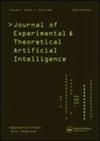融合临床和图像数据检测乳腺癌的严重程度通过一种新的分层方法
IF 1.7
4区 计算机科学
Q3 COMPUTER SCIENCE, ARTIFICIAL INTELLIGENCE
Journal of Experimental & Theoretical Artificial Intelligence
Pub Date : 2022-02-13
DOI:10.1080/0952813X.2021.1960629
引用次数: 1
摘要
在本文中,我们开发了一种结合聚类和分类常规的创新方法来检测乳腺癌的严重程度(阶段)并识别其是否转移。我们使用模糊c均值对数据进行聚类,并使用适当的分类程序来识别每个聚类的癌症严重程度。换句话说,我们使用分治规则来克服特征之间关系的非线性。此外,为了在测试数据或真实数据中获得更准确的分类,我们将每个数据的模糊隶属度与其他特征一起作为分类方法的输入集。我们研究的另一个优点是同时使用临床和图像特征,并在分类阶段使用主成分分析(PCA)提取新的特征。尽管一个病人可能属于多个簇,但对每个病人的所有相应分类方法的结果被适当地组合起来,最终得到癌症病人的阶段。最后,为了研究所提出的混合方法的效率,我们使用了包含临床和图像数据的七个真实数据集。本文章由计算机程序翻译,如有差异,请以英文原文为准。
Fusing clinical and image data for detecting the severity of breast cancer by a novel hierarchical approach
ABSTRACT In this paper, we developed an innovative approach combining clustering and classification routines to detect breast cancer severity (stage) and recognise whether or not it metastasises. We use Fuzzy C-mean to cluster data and a proper classification routine to recognise the severity of cancer for each cluster. In other words, we use the divide-and-conquer rule to overcome the nonlinearity of relations between features. Moreover, to have a more accurate classification in the test or real data, we impose the fuzzy membership of each data to a cluster along with other features as the set of input into the classification method. Another advantage of our research study is to use both clinical and image features and to extract new features using principal component analysis (PCA) for the classification phase. Whereas a patient might belong to more than one cluster, the results of all corresponding classification methods for the respective patient are appropriately combined to end up with the stage of the cancerous patient. Ultimately, to investigate the efficiency of the proposed hybrid approach, we use seven real data sets with both clinical and image data.
求助全文
通过发布文献求助,成功后即可免费获取论文全文。
去求助
来源期刊
CiteScore
6.10
自引率
4.50%
发文量
89
审稿时长
>12 weeks
期刊介绍:
Journal of Experimental & Theoretical Artificial Intelligence (JETAI) is a world leading journal dedicated to publishing high quality, rigorously reviewed, original papers in artificial intelligence (AI) research.
The journal features work in all subfields of AI research and accepts both theoretical and applied research. Topics covered include, but are not limited to, the following:
• cognitive science
• games
• learning
• knowledge representation
• memory and neural system modelling
• perception
• problem-solving

 求助内容:
求助内容: 应助结果提醒方式:
应助结果提醒方式:


